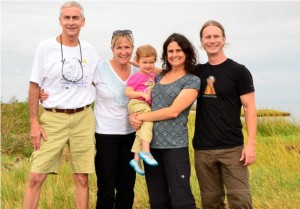Distance to a Road: 7.6 miles
Cell Phone Coverage: Yes
Public Land: No, Private
Travel Method: Motorboat
Travel Time One-Way: 1.5 hours
Something We Learned: Islands in the Chesapeake Bay are susceptible to rising sea levels and erosion to the point that they are becoming uninhabitable and disappearing altogether.
Project Remote is working to precisely calculate and travel to the remotest locations in each of the 50 United States. Below is a written account of our 1-day boating expedition to document the Maryland Remote Spot. This is our 7th state Remote Spot documented as part of Project Remote.
Click on the ‘Play’ button below to view our panoramic video of the Remote Spot
Together with Rebecca’s dad, Mike, and stepma, Tina, we launch our jon boat from Deal Island and motor over to Holland Island, a distance of about 8 miles. Because our boat is a flats boat, with low gunwales and a flat bottom, weather conditions have to be just right to travel across such large open waters. Although the weather isn’t beautiful (overcast with a constant threat of rain) the conditions on the water are perfect. The winds are almost non-existent and the water is glassy.
Our target island is not immediately visible, so we navigate using a combination of GPS, island landmarks, and nautical charts. We (Ryan and Rebecca) are grateful to have Chesapeake Bay experts on board! It would be nice to go planar but the water depths keep us at an idle until we find a channel.
We dodge crab pots, sand bars, and small islands until we see Holland Island in the distance, marked by several clumps of trees. The trees on the island are completely covered with pelicans and cormorants. Once supporting a population of more than 360 people, the island now is home to brown pelicans, egrets, gulls, terns, sandpipers and many other shorebirds and waterfowl.
We skirt around to the south side and land directly on the Spot; the edge of an eroding island. While doing research on the Remote Spot, we came across a Washington Post article with a headline that said the island on which the Spot is located is sinking into the Bay. It seems that a combination of erosion, rising sea levels, and settling from past Ice Age glacial activity is continually reducing the land area of Holland Island. We contacted the Holland Island Preservation Foundation to find out if the Remote Spot was actually under water now. We learned that the south end of the island is higher ground and our Remote Spot calculation was preserved.
GPS verification — We have arrived!
Celebrating Dad and Tina’s first Remote Spotting adventure! It is pretty exciting having my dad as a part of our experience. He has always been game to be a part of my life, be it taking me and my girlfriends to Bon Jovi in the 80’s or chasing salamanders in West Virginia in the 90’s. But what a superlative way for him to see what Project Remote is all about. Now perhaps his response to the frequently asked question, “What does your daughter do?” can be answered a little easier…
Turning off the motor, we hear only the peaceful quietude of water lapping against the land. The irony does not escape us, we are the only thing disrupting the silence of this Remote Spot right now. It is almost surreal being at this Remote Spot, knowing a thriving community once was here and imagining the fishing activity, houses, and people that were once a part of this island.
Confirming cell phone coverage, one of our standard data points at each Remote Spot. In fact, all 4 of the mid-Atlantic coastal spots we have visited this trip have had cell phone coverage (DE, NJ, MD, and VA).
At every Remote Spot we spend 15 minutes recording and quantifying the sights, sounds, and smells of the Spot. Called a Remote Spot Assessment, we use these data to measure things like evidence of human presence as well as to note ecological conditions.
Bits of mollusk and crab shells embedded along the island edge.
The most remote family in Maryland!
We are pretty isolated out here, no humans in sight, just large expanses of bay and marsh islands. We did record human sound during our Remote Spot Assessment, in the form of an airplane and a boat motor, but if our boat were to float away we likely wouldn’t be spotted by anyone any time soon.
The waves are picking up. It is time to leave as we have a long trip back across an open Bay, and the sky isn’t looking any better. We decide to circle the island so we can thoroughly explore the Remote Spot…plus we want to check out the rumor that there is still a bulldozer on the island, evidence of a failed attempt to save the last remaining home from falling into the Bay. The bulldozer now appears to be perching habitat for pelicans…
These smaller islands used to be part of the larger island, but now are separated by the Chesapeake. As we round the bend we see two motorboats with people fishing… guess we weren’t so remote after all….
The trip back is peaceful as the late afternoon light wanes. The Bay remains smooth and glassy and we rejoice in our luck to have such calm conditions on the Chesapeake. We celebrate the success of our MD Remote Spot expedition with beer, wine, and famous Cristfield crabcakes…and we start talking about tomorrow’s plan to hit the VA Remote Spot…
Project Remote Fundraiser: After reading this website, you might be surprised at just how hard it is to get away from a road or a town nowadays-and instantly understand that we must now as a nation speak out to protect remaining public roadless areas from further roads development. Project Remote is now over half-way done! Our goal is to raise enough funding simply to offset the cost of traveling frugally state by state, completing the documentary field work, and maintaining this website. This work depends on donations from people like you. If you like what we do, please Click here to make a donation to support Project Remote today. Thank you so very much for helping us to document and preserve Remote America… -Remote Spotters


